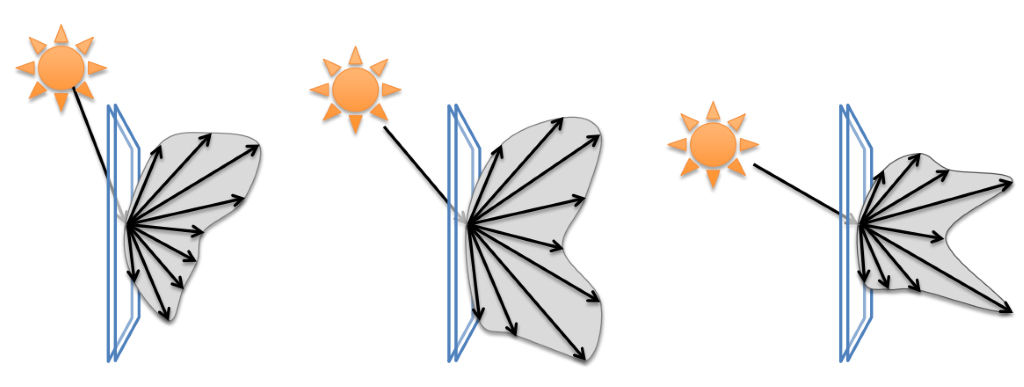Downloads
DOI:
https://doi.org/10.7480/jfde.2018.3.2531Keywords:
Complex fenestration systems, building performance simulation, bi-directional scattering distribution functions, reflective lamella, modeling complexityAbstract
This article presents an overview of possibilities and points of attention for modelling the performance of dynamic CFS in building performance simulation software. Following a detailed analysis of the unique requirements that are associated with modelling of CFS, a comparative study of the capabilities in different software implementations is presented. In addition, we present on overview of state-of-the-art approaches to obtain the necessary Bi-directional Scattering Distribution Functions (BSDF), involving experimental characterisation, databases, and component-level ray-tracing approaches. The second part of the paper provides a detailed discussion of a case study of a high reflective lamella system. This case study complements the review with hands-on information from a practical example and highlights the importance of developing models at the right level of complexity, taking into account the type of questions that the simulation intends to answer and the required accuracy level to do so.
How to Cite
Published
Issue
Section
License
Copyright (c) 2018 Giuseppe De Michele, Roel Loonen, Hemshikha Saini, Fabio Favoino, Stefano Avesani, Luca Papaiz, Andrea Gasparella

This work is licensed under a Creative Commons Attribution 4.0 International License.
Authors or their institutions retain copyright to their publications without restrictions.
References
Appelfeld, D., McNeil, A., & Svendsen, S. (2012). An hourly based performance comparison of an integrated micro-structural perforated shading screen with standard shading systems. Energy and Buildings, 50, pp.166–176. http://doi.org/10.1016/j.enbuild.2012.03.038
Berkeley Lab. (2007). LBNL WINDOW 7. Retrieved from http://windows.lbl.gov/software/window/window.html
Bueno, B., Wienold, J., Katsifaraki, A., & Kuhn, T. E. (2015). Fener: A Radiance-based modelling approach to assess the thermal and daylighting performance of complex fenestration systems in office spaces. Energy and Buildings, 94, pp.10–20. http://doi.org/10.1016/j.enbuild.2015.02.038
De Michele, G., Filippi Oberegger, U., & Baglivo, L. (2015). Coupling dynamic energy and daylighting simulations for complex fenestration systems. In Building Simulation Applications 2015 - 2nd IBPSA-Italy Conference. Bolzano-Bozen.
Frontini, F., Kuhn, T. E., Herkel, S., Strachan, P., & Kokogiannakis, G. (2009). Implementation and application of a new bi-directional solar modelling method for complex facades within the ESP-r building simulation program. Eleventh International IBPSA Conference,pp.936–943. Retrieved from http://ibpsa.org/proceedings/BS2009/BS09_0928_935.pdf
Gong, J., Kostro, A., Motamed, A., & Schueler, A. (2016). Potential advantages of a multifunctional complex fenestration system with embedded micro-mirrors in daylighting. Solar Energy, 139, pp.412–425. http://doi.org/10.1016/j.solener.2016.10.012
Hiller, M., & Schöttl, P. (2014). MODELLIERUNG KOMPLEXER VERGLASUNGSSYSTEME IN TRNSYS. BauSim pp. 387–394.
Hoes, P., Loonen, R. C. G. M., Trčka, M., & Hensen, J. L. M. (2012). Performance prediction of advanced building controls in the design phase using ESP-r, BCVTB and Matlab. In Proceedings of Building Simulation and Optimization. Loughborough, UK.
Hoffmann, S., Lee, E. S., & Clavero, C. (2014). Examination of the technical potential of near-infrared switching thermochromic windows for commercial building applications. Solar Energy Materials and Solar Cells, 123, pp.65–80. http://doi.org/10.1016/j.solmat.2013.12.017
IES, I. E. S. (2012). Approved Method: IES Spatial Daylight Autonomy (sDA) and Annual Sunlight Exposure (ASE).
ISO 15099:2003: (2003). Thermal performance of windows, doors and shading devices — Detailed calculations.
Klems, J. H. (1994). A new method for predicting the solar heat gain of complex fenestration systems - II. Detailed description of the matrix layer calculation. ASHRAE Transactions, 100(1), pp.1065–1072. http://doi.org/citeulike-article-id:10521068
Kuhn, T. E., Herkel, S., Frontini, F., Strachan, P., & Kokogiannakis, G. (2011). Solar control: A general method for modelling of solar gains through complex facades in building simulation programs. Energy and Buildings, 43(1), pp.19–27. http://doi.org/10.1016/j.enbuild.2010.07.015
Lomanowski, B. A., & Wright, J. L. (2012). The Complex Fenestration Construction: a practical approach for modelling windows with shading devices in ESP-r. Journal of Building Performance Simulation, 5(January), pp.185–198. http://doi.org/10.1080/19401493.2011.552735
Loonen, R. C. G. M., Favoino, F., Hensen, J. L. M., & Overend, M. (2017). Review of current status, requirements and opportunities for building performance simulation of adaptive facades†. Journal of Building Performance Simulation, 10(2). http://doi.org/10.1080/19401493.2016.1152303
Loonen, R. C. G. M., Singaravel, S., Trčka, M., Cóstola, D., & Hensen, J. L. M. (2014). Simulation-based support for product development of innovative building envelope components. Automation in Construction, 45. http://doi.org/10.1016/j.autcon.2014.05.008
Mardaljevic, J., & Nabil, A. (2005). The Useful Daylight Illuminance Paradigm: A Replacement for Daylight Factors. Lux Europa, Berlin, pp.169–174.
McNeil, A., Jonsson, C. J., Appelfeld, D., Ward, G., & Lee, E. S. (2013). A validation of a ray-tracing tool used to generate bi-directional scattering distribution functions for complex fenestration systems. Solar Energy, 98(PC), pp.404–414. http://doi.org/10.1016/j.solener.2013.09.032
Reinhart, C. F., Mardaljevic, J., & Rogers, Z. (2006). Dynamic daylight performance metrics for sustainable building design. LEUKOS - Journal of Illuminating Engineering Society of North America, 3(1), pp.7–31. http://doi.org/10.1582/LEUKOS.2006.03.01.001
Saini, H., Loonen, R. C. G. M., & Hensen, J. L. M. (2018). Simulation-based performance prediction of an energy-harvesting façade system with selective daylight transmission. In Proceedings of ICAE2018 - International Congress on Architectural Envelopes. San Sebastian, Spain.
Subramaniam, S. (2017). Daylighting Simulations with Radiance using Matrix-based Methods. Retrieved from https://radiance-online.org/learning/tutorials/matrix-based-methods
US Department of Energy. (2010). EnergyPlus Engineering Reference: The Reference to EnergyPlus Calculations. US Department of Energy, (c), pp.1–847. http://doi.org/citeulike-article-id:10579266
Vera, S., Uribe, D., & Bustamante, W. (2017). Optimization of a fixed exterior complex fenestration system considering visual comfort and energy performance criteria. Building and Environment, 113(June), pp.11–14. http://doi.org/10.1016/j.buildenv.2016.07.027
Ward, J, G. (1989). The RADIANCE Lighting Simulation and Rendering System. 21st Annual Conference on Computer Graphics and Interactive Techniques, pp.459–472. Retrieved from http://radsite.lbl.gov/radiance/papers/sg94.1/Siggraph1994a.pdf
